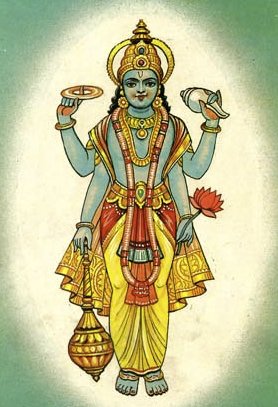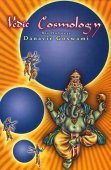Pushkaradvipa, Puṣkaradvīpa, Pushkara-dvipa: 12 definitions
Introduction:
Pushkaradvipa means something in Hinduism, Sanskrit, Jainism, Prakrit. If you want to know the exact meaning, history, etymology or English translation of this term then check out the descriptions on this page. Add your comment or reference to a book if you want to contribute to this summary article.
The Sanskrit term Puṣkaradvīpa can be transliterated into English as Puskaradvipa or Pushkaradvipa, using the IAST transliteration scheme (?).
In Hinduism
Vaishnavism (Vaishava dharma)
Source: Google Books: Sri Brhad-bhagavatamrta, vol 2Puṣkaradvīpa (पुष्करद्वीप).—On Puṣkara-dvīpa, within the bhū-maṇḍala system, Lord Brahmā is worshiped as a representative of the Personality of Godhead. Gopa-kumāra, who knew nothing about Lord Brahmā’s existence, simply describes what he physically saw.

Vaishnava (वैष्णव, vaiṣṇava) or vaishnavism (vaiṣṇavism) represents a tradition of Hinduism worshipping Vishnu as the supreme Lord. Similar to the Shaktism and Shaivism traditions, Vaishnavism also developed as an individual movement, famous for its exposition of the dashavatara (‘ten avatars of Vishnu’).
Purana and Itihasa (epic history)
Source: Wisdom Library: Varāha-purāṇaPuṣkaradvīpa (पुष्करद्वीप) is one of the seven islands (dvīpa), ruled over by Savana, one of the ten sons of Priyavrata, according to the Varāhapurāṇa chapter 74. Priyavrata was a son of Svāyambhuva Manu, who was created by Brahmā, who was in turn created by Nārāyaṇa, the unknowable all-pervasive primordial being.
Source: Cologne Digital Sanskrit Dictionaries: The Purana IndexPuṣkaradvīpa (पुष्करद्वीप).—The island twice the Dadhimaṇḍoda in size, and surrounded by sea of fresh water: named after a huge lotus with golden petal intended to be Brahmā's throne: called after the King Puṣpavāhana of Rathantarakalpa; here is the hill Citrasānu. There is only one mountain Mānasottara in the middle of this dvīpa, dividing it into portions East and West. On it in the four directions are the cities of gods like Indra. On its top rotates the wheel of the Sun's chariot which makes the year of men and the day of gods. Vītihotra, a son of Priyavrata was the ruler who divided it among his two sons. Brahmā is worshipped here;1 here people live for 10000 years. No caste or Vedas: worship banyan tree: Kaśyapa performed his Aśvamedha and Vāli defeated Rāvaṇa;2 visited by Paraśurāma;3 one of the seven continents of which Savana was the first King. His sons Mahāvīra and Dhātuki divided it between them.4
- 1) Bhāgavata-purāṇa V. 1. 32; 20. 29-33; Matsya-purāṇa 100. 4; 123. 13; 248. 13; Vāyu-purāṇa 49. 101-141.
- 2) Brahmāṇḍa-purāṇa II. 14. 14; 19. 108-26, 140-1; III. 5. 7; 7. 267.
- 3) Ib. III. 32. 60; 44. 22; Viṣṇu-purāṇa II. 4. 72-86, 92.
- 4) Ib. II. 1. 15; 2. 5.

The Purana (पुराण, purāṇas) refers to Sanskrit literature preserving ancient India’s vast cultural history, including historical legends, religious ceremonies, various arts and sciences. The eighteen mahapuranas total over 400,000 shlokas (metrical couplets) and date to at least several centuries BCE.
Kavya (poetry)
Source: Shodhganga: A critical appreciation of soddhalas udayasundarikathaPuṣkaradvīpa (पुष्करद्वीप).—One of the seven continents (dvīpa) of Bhūrloka (earth).—In the Puṣkaradvīpa, there is a big banyan tree in the lotus-form. The Puṣkaradvīpa is encircled by an ocean (samudra) of sweet water.
Source: Shodhganga: The Kavyamimamsa of RajasekharaPuṣkaradvīpa (पुष्करद्वीप) is the name a locality mentioned in Rājaśekhara’s 10th-century Kāvyamīmāṃsā.—It is one the seven Dvīpas in the world. Jambūdvīpa is situated in the middle place, while the Puṣkara is the third from Jambū.

Kavya (काव्य, kavya) refers to Sanskrit poetry, a popular ancient Indian tradition of literature. There have been many Sanskrit poets over the ages, hailing from ancient India and beyond. This topic includes mahakavya, or ‘epic poetry’ and natya, or ‘dramatic poetry’.
Shaivism (Shaiva philosophy)
Source: Wisdom Library: ŚaivismPuṣkaradvīpa (पुष्करद्वीप) refers to one of the seven continents (saptadvīpa) situated within the world of the earth (pṛthivī), according to Parākhyatantra 5.61. It is also known as plainly Puṣkara. These continents are located above the seven pātālas and may contain even more sub-continents within them, are round in shape, and are encircled within seven concentric oceans.
According to the Parākhya-tantra, “outside that is the continent Puṣkara, where flows the river Puṣkariṇī, with sweet waters like those of the ocean of nectar, frequented by gods and Siddhas. Beyond that is the ocean of nectar, in which there is sweet-tasting nectar, and where the gods drink for the sake of the pleasure it gives their bodies”.
The Parākhyatantra is an old Śaiva-siddhānta tantra dating from before the 10th century.

Shaiva (शैव, śaiva) or Shaivism (śaivism) represents a tradition of Hinduism worshiping Shiva as the supreme being. Closely related to Shaktism, Shaiva literature includes a range of scriptures, including Tantras, while the root of this tradition may be traced back to the ancient Vedas.
In Jainism
General definition (in Jainism)
Source: Wisdom Library: JainismPuṣkaradvīpa (पुष्करद्वीप) is one of the continents (dvīpa) of the middle-world (madhyaloka), encircled by the ocean named Puṣkarodasamudra (or simply Puṣkaroda), according to Jain cosmology. The middle-world contains innumerable concentric dvīpas and, as opposed to the upper-world (adhaloka) and the lower-world (ūrdhvaloka), is the only world where humans can be born. Puṣkaradvīpa is also known as Puṣkaravaradvīpa and as plainly Puṣkara.
Puṣkaradvīpa is recorded in ancient Jaina canonical texts dealing with cosmology and geography of the universe. Examples of such texts are the Saṃgrahaṇīratna in the Śvetāmbara tradition or the Tiloyapannatti and the Trilokasāra in the Digambara tradition.
Source: archive.org: TrisastisalakapurusacaritraPuṣkaradvīpa (पुष्करद्वीप) (or Puṣkara) is the name of the continent surrounding the Kāloda ocean which is situated in the “middle world” (madhyaloka), according to chapter 2.3 [ajitanātha-caritra] of Hemacandra’s 11th century Triṣaṣṭiśalākāpuruṣacaritra: an ancient Sanskrit epic poem narrating the history and legends of sixty-three illustrious persons in Jainism.
Accordingly:—“The definition of names and objects—Iṣvākāra, Meru, etc.—which was given for Dhātakī is true also for half of Puṣkara (i.e., Puṣkaradvīpa). But in this half of Puṣkara the divisions of the country, etc., are known to be twice as large as the divisions of the country, etc., of Dhātakīkhaṇḍa. There are 4 small Merus in Dhātakī and half of Puṣkara, smaller than Meru by 15,000 yojanas. At the ground their diameter is less than Meru’s by 600 yojanas. [...]”.
Source: JAINpedia: GlossaryPuṣkara-dvīpa:—The third continent of the middle world of Jain cosmology. Human beings can live only in the first two circular continents and the inner half of the third. Puṣkara-dvīpa is enclosed by a circular mountain barrier known as Mānuṣottara-parvata or “Mountain beyond Mankind”. Human beings cannot live on the outer side of these mountains.
Source: Encyclopedia of Jainism: Tattvartha Sutra 3: The Lower and middle worldsPuṣkaradvīpa (पुष्करद्वीप) or Puṣkaravaradvīpa refers to the third continent of the Madhya-loka (middle-word), according to the 2nd-century Tattvārthasūtra 3.7. The number of regions and mountains in the Pusikarārdha continent is same as in Dhātakīkhaṇda continent. In Pusikarārdha continent there are two Merus, namely Mandara and Vidhyunamāli, two Isivakāra mountains two Bharata regions, two Himavāna, etc.
How did the Puṣkara continent get its name? The tree Pusikara grows in the Pusikara continent. Hence, the name is assigned as Pusikarārdha continent.

Jainism is an Indian religion of Dharma whose doctrine revolves around harmlessness (ahimsa) towards every living being. The two major branches (Digambara and Svetambara) of Jainism stimulate self-control (or, shramana, ‘self-reliance’) and spiritual development through a path of peace for the soul to progess to the ultimate goal.
Languages of India and abroad
Sanskrit dictionary
Source: Cologne Digital Sanskrit Dictionaries: Monier-Williams Sanskrit-English DictionaryPuṣkaradvīpa (पुष्करद्वीप):—[=puṣkara-dvīpa] [from puṣkara > puṣ] m. Name of a Dvīpa or great division of the earth, [cf. Lexicographers, esp. such as amarasiṃha, halāyudha, hemacandra, etc.]
[Sanskrit to German]
Sanskrit, also spelled संस्कृतम् (saṃskṛtam), is an ancient language of India commonly seen as the grandmother of the Indo-European language family (even English!). Closely allied with Prakrit and Pali, Sanskrit is more exhaustive in both grammar and terms and has the most extensive collection of literature in the world, greatly surpassing its sister-languages Greek and Latin.
See also (Relevant definitions)
Partial matches: Pushkara, Dvipa.
Full-text (+27): Dhatakikhanda, Savana, Dhataki, Saptadvipa, Manushottara, Pushkara, Dhatakishanda, Dhahakikhanda, Citrasanu, Shilpa, Prithivi, Dakshinayana, Shakadvipa, Mauhurttikagati, Jambudvipa, Vaṇikpatha, Pushkarodasamudra, Mahavita, Kancanapura, Kaumuda.
Relevant text
Search found 22 books and stories containing Pushkaradvipa, Pushkara-dvipa, Puṣkara-dvīpa, Puskara-dvipa, Puṣkaradvīpa, Puskaradvipa; (plurals include: Pushkaradvipas, dvipas, dvīpas, Puṣkaradvīpas, Puskaradvipas). You can also click to the full overview containing English textual excerpts. Below are direct links for the most relevant articles:
Historical Elements in the Matsya Purana (by Chaitali Kadia)
Saptadvīpa (7): Puṣkaradvīpa < [Chapter 4 - Geographical history in the Matsya-Purāṇa]
The concept of Saptadvīpa (seven islands) < [Chapter 4 - Geographical history in the Matsya-Purāṇa]
Brihad Bhagavatamrita (commentary) (by Śrī Śrīmad Bhaktivedānta Nārāyana Gosvāmī Mahārāja)
Verse 2.2.121 < [Chapter 2 - Jñāna (knowledge)]
Verse 2.2.123 < [Chapter 2 - Jñāna (knowledge)]
Garga Samhita (English) (by Danavir Goswami)
Verse 2.22.18 < [Chapter 22 - The Rāsa-dance Pastime]
The Brahma Purana (by G. P. Bhatt)
The Devi Bhagavata Purana (by Swami Vijñanananda)
Chapter 13 - On the description of the remaining Dvīpas < [Book 8]
Chapter 4 - On the narration of the family of Priyavrata < [Book 8]
The Linga Purana (by J. L. Shastri)
Chapter 53 - Geography of the World < [Section 1 - Uttarabhāga]
Chapter 46 - Dvīpas and their Lords < [Section 1 - Uttarabhāga]
Related products
